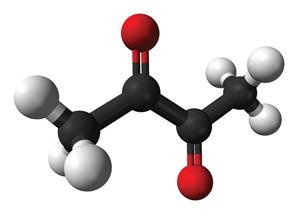Diacetyl
Diacetyl has a pretty bad rap as a constituent of beer. Its butterscotch flavor is generally regarded as a fault. It is true that many people find its taste objectionable, and that it can be detected in relatively small concentrations, but I think it only fair to point out that some of the objections against diacetyl reflect indoctrination rather than judgement. This is because most of the research involving testing of diacetyl’s effects was done using high-production pale yellow lagers as a base. As a matter of fact, beers with high non-malt adjunct levels tend to have high diacetyl levels. One study showed that increasing adjunct levels from 20% to 40% doubled the diacetyl concentration in the beer. Further, in such beers, which are not meant to have much in the way of flavor, that butterscotch flavor does stand out and spoil the brewer’s designs for the beer’s palate.
A result of this is that beer aficionados often look specifically for diacetyl when they taste a brew rather than looking at its overall palate. Not surprisingly, some of them find diacetyl even when it isn’t present. Some tasters also forget that diacetyl flavor is not necessarily objectionable to all drinkers, and that that dreaded butterscotch flavor can actually add to — and help to round off — the palate of more complex beers. I remember my first taste of Samuel Smith’s Bitter when I lived in Yorkshire in England back in the 1970s. It had a flavor quite distinct from most other bitter ales, one which I enjoyed and later found out was due to the presence of diacetyl, which was not removed during fermentation in Yorkshire Stone Square vessels. Perhaps you don’t believe me? Well let me refer you to the December 2010 issue of BYO in the “Tips from the Pros.” John Lyda, Brewmaster and VP at Highland Brewing Company in Asheville,
North Carolina discussed Cold Mountain Winter Ale and said, “We also intentionally leave in some diacetyl to help with the overall roundness of the beer.”
Well, now that my little rant is over, let’s get down to more practical things. Some people do not like diacetyl in beer, and it does have a very low taste threshold. A quick check of the literature reveals this with two very well-respected brewing texts quoting a) 0.1 –0.14 μg/mL and b) 0.5 μg/mL, both for lager beers. Translating to more sensible numbers, the higher figure represents 0.5 mg/L or 0.5 ppm.
Whatever unit you use, it is a small concentration, so ensuring that your beer does not contain too much of it can be a little tricky. But, what is it and how does it get into your beer?
A little light chemistry
Diacetyl, perhaps more properly called 2, 3-butanedione, is a vicinal diketone, which means it has two carbonyl groups situated on adjacent carbon atoms. It is produced during fermentation by decarboxylation and oxidation of alpha-acetolactate (a yeast metabolite).
This is a chemical reaction (as opposed to an enzymatic one) and occurs outside the cell. It’s a relatively slow reaction, but is accelerated both by higher temperatures and by lower pH.
All very interesting, but do you as a brewer need to know this? Perhaps not, but it indicates two things, firstly that diacetyl can be removed by a reduction reaction (yielding 2,3-butanediol, which is neutral in beer flavor terms). Secondly, it may not be enough just to remove the diacetyl if its precursor, α-acetolactate is still present in significant concentration as it may later be converted to diacetyl. In short, you need to reduce both of these fermentation metabolites. Of course, the simplest thing to do would be to prevent the formation of α-acetolactate in the first place, wouldn’t it? Well unfortunately that does not appear to be an option, for as yeast goes about its merry way converting carbohydrates to things that we like, such as alcohol and carbon dioxide, it insists on producing these two compounds that we don’t want!
Away with it!
So how do we remove diacetyl and α-acetolactate? Well, we don’t — the yeast does. Our friendly fungus, bless its little cotton socks, having put these nasties there in the first place can remove them later on. As fermentation comes towards its end, the yeast can absorb diacetyl into the cell and there reduce it enzymatically to 2,3-butanediol. If the green beer is held under the right conditions both diacetyl and its precursor can be removed by the yeast. Those conditions are simple enough, for the beer needs to be held at a reasonably high temperature in the presence of active yeast. Reasonably high temperature means around 65–70 °F (18–21 °C), which is enough to ensure full conversion of α-acetolactate to diacetyl, and with enough yeast present to reduce the diacetyl. You can’t expect much in the way of diacetyl level reduction during secondary fermentation, because you have racked the beer off of most of the yeast. For practical purposes this “diacetyl rest” is best done in the primary fermenting vessel.
It should be obvious from this where the problem with diacetyl in lager arises. Primary fermentation at, say, 40–45 °F (4.5–7.2 °C), followed directly by lagering will probably remove little of the α-acetolactate and diacetyl formed earlier. This is likely to result in diacetyl levels well above the taste threshold when the beer is drunk. And that is why most (if not all) commercial lager brewers take the green beer through a diacetyl rest by taking it up to a warmer temperature after the primary stage.
It should also be obvious that there is less likely to be a diacetyl problem in ale brewing because of the higher temperatures used in the primary stage — providing you allow the beer to “sit” on the yeast once the vigorous stage of primary fermentation has ceased. But if you rack the beer right after this, there may not be enough active yeast present in the secondary to remove all the diacetyl. With most yeast strains this is unlikely to occur, but it can happen if your strain is highly flocculent. And of course this is a good argument for never rushing things — give the beer a little time in the primary and secondary stages. If you use a good strain and a sufficient quantity of active starter your ale may have reached finishing gravity after only two or three days. Don’t be fooled by that into thinking that you can then rack it directly into your keg using isinglass or gelatin finings to ensure clarity. Unless of course you are one of those drinkers who loves the taste of diacetyl! If the latter is the case, think about using a yeast noted for diacetyl production, such as the Ringwood strain.
Recap
So let’s go over the procedure to ensure a low level of diacetyl in detail. I am assuming that you are not trying to control diacetyl to a specific concentration as they do at Highland Brewing, which is very difficult without sophisticated analytical techniques, or without a very good knowledge of what to expect from the yeast strain you are using. I should also point out that Jamil Zainasheff discussed this on p. 22 in his “Style Profile” column on German Pilsner in the December 2010 issue of BYO. I have no problem in going over this again, as control of diacetyl levels is of concern to many people and the procedure is not always well understood.
Lager brewing is the area of most concern. Carry out the primary at your chosen temperature, say 40–50 °F (4–10 °C), then bring the beer temperature up to 65 °F (18 °C). Hold it there for two or three days then cool gradually to the desired lagering temperature. Ideally you want to start the diacetyl rest slightly before reaching finishing gravity so that there is still active yeast suspended in the beer. In practice this is difficult to determine, and you need to look for a slowing in vigorous fermentation to start the rest. Look for when the yeast head has collapsed back into the beer and relatively few gas bubbles are coming to the surface, but before the beer shows visible signs of clearing.
Ale brewing is much simpler. All you need to do is to maintain the beer at primary fermentation temperature (65–70 °F, 18–21 °C) for two to three days after the vigorous stage has ceased (this should take three to five days with a good, vigorous yeast starter). Do not be in a hurry to rack the beer to the secondary, although diacetyl levels can still be lowered in the secondary, depending upon how much of the yeast is carried over.
But wait, there’s more!
The above deals with diacetyl produced by yeast, but that may not be the only cause of its presence in beer. For it can be produced by certain bacteria, notably Pediococcus, and to a much lesser extent Lactobacilli. This can take place in the finished beer, after fermentation and after most or all of the yeast has been removed. Pediococcus is capable of taking diacetyl levels up to 3ppm, well above the taste threshold for this chemical. There is nothing you can do to prevent diacetyl formation if the bacteria are present.
Like many beer-spoilage bacteria, the reaction would be expected to occur only slowly. That is because there are usually only very low levels of Pediococcus bacteria in the beer after fermentation and it takes some time for them to grow to high enough levels to do any damage. However, I know one example where it happened quite rapidly. My fellow brewers and I were taking a cask of pale ale from Brü Rm@BAR (in New Haven, Connecticut) to a local festival, and carefully racked off the beer from its serving tank (that is after filtration) into the cask. We checked it out as we did so, and found it clean with no signs of any contamination. The next day it was set up at the festival and connected to a hand pump for serving. We tasted it again, only to find it was loaded with diacetyl!
What had happened was obvious after the fact. We had been in somewhat of a hurry and had not checked out the hand pump, which had been sitting around on a back shelf for some time. Clearly it had developed a significant amount of Pediococcus, enough to raise the diacetyl level of the beer almost on contact. What was worse was that we had no way of cleaning the pump, and no time to do it before the festival opened. Luckily, it turned out that after drawing off more of the beer it became clear of diacetyl and we were saved — at the expense of throwing away a few pints of beer and of enduring some unexpected stress. But it was a lesson to us, and shows that even self-proclaimed experts can make elementary mistakes!
You cannot normally cure a beer infected in this way; prevention of infection is the only answer. A brewer is first and foremost a cleaner, and if you scrupulously adhere to hygiene in the brewery, you should avoid this problem. Note that the most likely place for such an infection to occur is in serving lines used in dispensing the beer from a keg. Do not leave picnic or other taps full of beer connected to the keg. Remove and clean them frequently and thoroughly and you should have no problem with this particular source of diacetyl.



